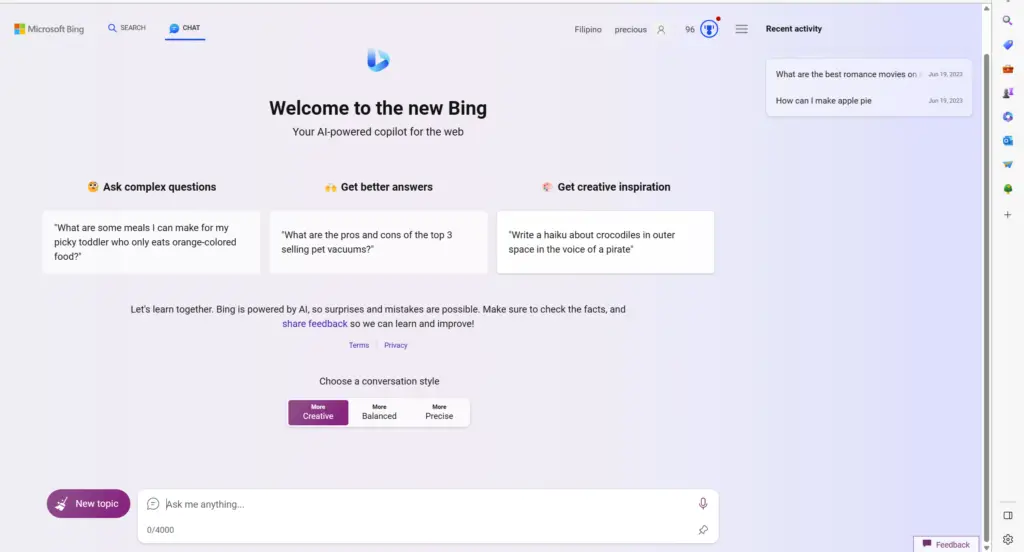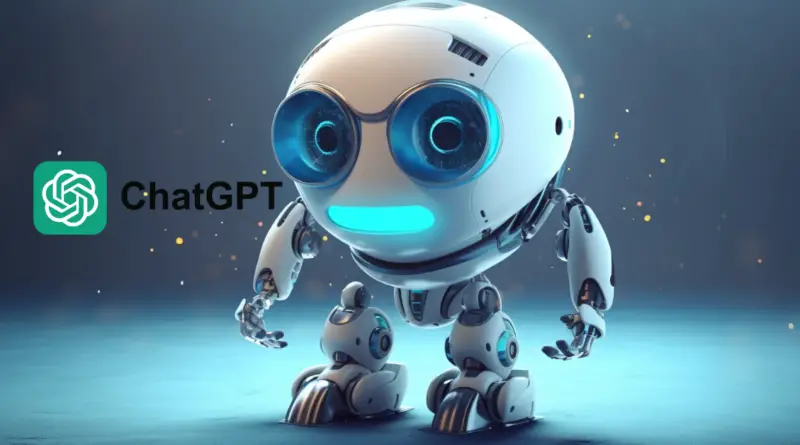What is ChatGPT? The Ultimate Guide For Beginners
Once considered a mere figment of science fiction, AI is now a tangible reality that surrounds us in various forms. From self-driving cars to virtual assistants, AI is fast becoming an integral part of our daily lives.
Among the many AI applications today, conversational bots have emerged as one of the most exciting developments, enabling human-like interactions between machines and users. You must have heard about ChatGPT by now and it’s jaw-dropping capabilities.
We are wowed too so in this comprehensive guide, we break down the simple but not-so-simple world of ChatGPT to understand its capabilities, applications, and impact.
What is ChatGPT and How Does It Work?
ChatGPT, developed by OpenAI, is an AI-powered conversational bot designed to engage in natural and interactive conversations with users. It uses a language model known as GPT (Generative Pre-trained Transformer) to generate human-like responses based on the input it receives.
The “GPT” in ChatGPT stands for Generative Pre-trained Transformer. This refers to the underlying technology that powers ChatGPT.
The technology behind ChatGPT is based on deep learning and natural language processing techniques. It has been trained on a vast corpus of text data from the internet, allowing it to develop a broad understanding of language patterns, grammar, and context. This enables ChatGPT to generate coherent and contextually relevant responses based on the input it receives.
OpenAI, the organization responsible for ChatGPT, has made significant contributions to the field of AI. It has pioneered research and development in areas such as language models, reinforcement learning, and robotics.
OpenAI’s mission is to ensure that AI is developed and deployed in a safe, beneficial, and ethical manner, with an emphasis on democratizing access to AI technologies.
See also: Who Owns ChatGPT & Open AI?
ChatGPT Text Generation
ChatGPT does not have direct access to the internet during a conversation. Its responses are generated solely based on the data it has been trained on and the input provided by the user (called prompts). However, it’s worth noting that the training data includes text from the internet, which indirectly incorporates information from online sources.
ChatGPT prompts are the user inputs or messages that you provide to the system. These prompts serve as the starting point for the conversation and help guide the responses generated by ChatGPT.
By providing clear and specific prompts, you can steer the conversation in the desired direction and obtain more relevant and accurate responses.
While ChatGPT can generate text that simulates human-like conversation, it is essential to note that the responses are algorithmically generated and not from a human source.
Although efforts have been made to prevent malicious use, it’s important to exercise caution when interacting with the system and avoid sharing sensitive or personal information.
Accessing ChatGPT
ChatGPT is available as a web-based application, accessible through a web browser, and does not require any installation. It means you can access and use ChatGPT on various devices, including desktop computers, laptops, tablets, and smartphones.
It can be accessed on any platform with internet connectivity including Android and iOS devices. You can use ChatGPT for free without a subscription but you would need to log in or create an account.
OpenAI provides access to ChatGPT for users to explore and engage with the system freely. However, OpenAI also offers a subscription plan called ChatGPT Plus, which provides additional benefits such as faster response times and priority access during peak usage.
How to Use ChatGPT For Free [ Step-by-Step Method]
To get started with ChatGPT, follow these simple steps:
Step 1: Visit The OpenAI ChatGPT Home Page and Sign Up
If you don’t have an account yet, navigate to the OpenAI ChatGPT page to sign up for an account.
Step 2: Click on Sign Up
After clicking on “Sign Up” provide the necessary information, including your email address and a secure password, to create your OpenAI account. You can also sign up using your Google, Microsoft, or Apple account
Step 3: Complete Sign-Up
Once you have filled in the required details, complete the account sign-up process by following the instructions provided. This typically involves confirming your email address by clicking on a verification link sent to your registered email.
As an added security measure, OpenAI may require you to verify your phone number. This verification step helps protect the platform and its users from potential misuse.
Step 4: Accept ChatGPT’s Terms and Conditions
After completing the sign-up and verification process, carefully review and accept the terms and conditions associated with using ChatGPT. Familiarize yourself with the guidelines and policies provided to ensure safe and respectful interaction with the system.
Step 5: Input Prompt and Start Using ChatGPT
With your OpenAI account set up and the necessary formalities completed, you’re now ready to start using ChatGPT. Access the ChatGPT interface through the OpenAI website or any supported platform. The user-friendly interface allows you to interact with ChatGPT seamlessly.
Begin a conversation with ChatGPT by entering a prompt in the text box at the bottom center of the page. It can be a question, a sentence, or any text that helps guide the conversation.
Click on “Regenerate response” for another response if you’re not satisfied with the output. You can also click the “Pls Continue” button at the top right corner of the screen for the bot to keep generating output.
Writing Templates
On the bottom left part of the screen, you can click on the “Templates” button to access a pre-written prompt you can use to generate a response.
The prompt templates can allow you to choose categories and subcategories through a drop-down menu. Category option ranges from copywriting to SEO, social media, marketing, and more.
ChatGPT Plus [ Cost, Features, Benefits]
In February 2023, OpenAI introduced a premium subscription service called ChatGPT Plus, offering users enhanced benefits and features for a monthly cost of $20. This optional subscription plan provides users with several advantages that elevate their experience with ChatGPT.
The most apparent advantage of subscribing to ChatGPT Plus is the availability of access even during peak times. As the popularity of ChatGPT soared, the demand for its services increased, occasionally resulting in temporary limitations on usage.
However, with ChatGPT Plus, subscribers enjoy uninterrupted access, ensuring they can engage with the system whenever they need it, regardless of the usage levels.
Another notable benefit of ChatGPT Plus is the significantly faster response time. Non-subscribers may occasionally experience slight delays in receiving responses due to system load.
However, ChatGPT Plus subscribers receive prioritized access, allowing them to receive quicker and more seamless responses from the AI-powered conversational bot. Early access to new features and improvements is an exclusive privilege reserved for ChatGPT Plus subscribers.
The cost of ChatGPT Plus is $20 per month, providing an affordable option for those seeking an enhanced and streamlined experience with ChatGPT. The subscription fee covers the additional benefits offered and contributes to supporting the availability of free access to ChatGPT for as many users as possible.
Also read: How to Pay For ChatGPT Plus [Explained!]
Uses and Applications of ChatGPT
ChatGPT, with its advanced conversational capabilities, has the potential to revolutionize numerous industries by reducing workload and increasing efficiency. Here are ten beneficial applications of ChatGPT
Sales and Marketing
This is one of the areas where the use of ChatGPT can in fact create a huge impact. ChatGPT can engage with potential customers, answer product-related queries, and provide personalized recommendations based on their preferences and needs.
It can also assist sales and marketing teams in lead generation, nurturing customer relationships, and improving conversion rates. In addition, the AI chatbot can help content creators by generating ideas, providing suggestions, and assisting in the writing process.
It can be a valuable tool for bloggers, journalists, and authors, saving time and offering creative insights.
Customer Support
The integration of ChatGPT can assist in customer support by providing instant responses to common queries, guiding customers through troubleshooting processes, and offering personalized recommendations, thereby reducing the workload on human customer service agents.
ChatGPT can enhance the online shopping experience by acting as a virtual shopping assistant. It can help customers find products, provide detailed information, and offer personalized suggestions based on their preferences, leading to increased sales and customer satisfaction.
Healthcare
In the healthcare industry, ChatGPT can assist with patient inquiries, appointment scheduling, and basic medical advice. It can act as a triage tool, helping patients with relevant information about their symptoms before they consult with healthcare professionals.
Note that you should proceed with care while using ChatGPT or any other chatbot for medically related-concerns. It is always best to consult with a doctor or a primary health care provider.
Education
ChatGPT can serve as a virtual tutor, offering personalized explanations, answering students’ questions, and providing additional resources. It can support students in their learning journey and help educators manage the workload associated with individualized attention.
Banking and Finance
The AI bot can handle routine banking tasks, such as balance inquiries, transaction history, and account management. It can also provide personalized financial advice based on individual goals and preferences, streamlining customer interactions and reducing wait times.
Travel and Hospitality
ChatGPT can assist travelers with itinerary planning, flight and hotel bookings, and recommendations for attractions and restaurants. It can also provide real-time information about travel restrictions, weather updates, and travel-related queries, ensuring a seamless travel experience.
Human Resources
The generative AI tool can help automate parts of the HR process, such as answering employee queries, providing information on company policies and benefits, and assisting with onboarding processes.
This can free up HR professionals to focus on strategic initiatives and employee development.
Legal Services
ChatGPT can assist with legal research, providing access to relevant case laws, statutes, and legal documents. It can help lawyers and legal professionals streamline their research processes, improve efficiency, and stay updated with the latest legal information.
Limitations and Controversies With Using ChatGPT
While ChatGPT offers impressive conversational abilities, there are several limitations and controversies associated with its usage. It’s important to be aware of these factors to ensure responsible and informed interactions. Let’s explore some of the key considerations:
Lack of Context Understanding and Low Emotional Intelligence
ChatGPT may sometimes struggle to understand the broader context of a conversation, resulting in responses that seem disconnected or lacking in relevance.
It may also lack emotional intelligence, which means it may not appropriately recognize or respond to emotions expressed by users. Replies might seem out of touch or robotic. This can impact the overall quality and depth of interactions.
Limited Knowledge
ChatGPT’s responses are generated based on the data it has been trained on, which primarily consists of text available on the internet.
While it has access to a vast amount of information, there may still be gaps in its knowledge. It’s important to critically evaluate the information provided by ChatGPT and cross-reference it with reliable sources for accuracy.
Biases and Incorrect Answers
As an AI language model, ChatGPT is susceptible to biases present in the data it was trained on. Biases in language, societal biases, or misinformation contained in the training data can influence the responses generated by ChatGPT.
OpenAI has made efforts to reduce biases, but it is crucial to be aware of this limitation and critically assess the information received.
Privacy Concerns
Privacy concerns are a significant consideration when using ChatGPT or any AI-powered service. While ChatGPT does not retain user-specific data after the conversation ends, the information shared during the interaction could potentially be logged and analyzed by OpenAI for research and system improvement purposes. It’s important to review and understand OpenAI’s privacy policies and terms of service.
See also: Does ChatGPT Track Your Browsing History?[Stay Protected!]
ChatGPT Banned in Italy
Controversy has also emerged around the use of ChatGPT in certain regions. For example, in March 2023, ChatGPT was temporarily banned in Italy due to concerns over its lack of compliance with European Union guidelines on automated decision-making systems.
However, by the end of April, ChatGPT was restored again after the regulatory criteria of the Italian authorities were fulfilled.
This highlights the ongoing discussions and regulatory challenges surrounding the use of AI technologies like ChatGPT.
It’s crucial to approach the use of ChatGPT with a critical mindset, understanding its limitations and potential biases. Users should exercise caution when relying on the information provided and seek additional verification when necessary.
Alternatives to ChatGPT You Can Try Out
While ChatGPT is a powerful conversational AI tool, there are also other alternatives available in the market that offer unique features and capabilities. Let’s explore some of these alternatives and their potential uses:
Bing Chat

Bing Chat is a conversational AI platform developed by Microsoft. It offers a range of features, including natural language understanding and response generation.
Bing Chat can be utilized for customer support, virtual assistants, and chatbot applications. It integrates well with Microsoft’s suite of products, making it a suitable choice for businesses already using Microsoft services.
Jasper AI
Jasper AI is an advanced conversational AI platform designed to provide personalized and context-aware interactions. Its machine learning algorithms allow it to understand user intents and provide intelligent responses. Jasper AI can be exceptionally helpful for content marketers, copywriters, and bloggers.
Google Bard
Google Bard, powered by Google’s language processing capabilities, offers a conversational AI platform that specializes in generating creative and engaging dialogues. It can be utilized in content creation, game development, and interactive storytelling. As of this time, it is still an experiment by Google.
Chatsonic
Chatsonic is a versatile AI-powered chatbot platform that provides a range of features, including natural language processing, sentiment analysis, and speech recognition. Chatsonic’s flexibility and comprehensive set of features make it suitable for businesses across various industries.
Character AI
Character AI is an innovative conversational AI tool that focuses on creating lifelike and interactive virtual characters. It enables developers to build virtual personalities with realistic behavior and speech patterns.
Character AI finds applications in gaming, virtual reality experiences, and interactive storytelling, providing immersive and engaging user interactions.
These alternatives to ChatGPT offer distinct features and cater to specific use cases. When considering which tool to utilize, it’s essential to consider your requirements and needs
Common Terms Associated With ChatGPT and AI You Should Know
Understanding these popular terms associated with ChatGPT and AI will help you navigate conversations and discussions related to artificial intelligence and its applications. These terms provide a foundation for comprehending the technology behind ChatGPT and its broader context within the field of AI.
| Term | Explanation/Definition |
| Artificial Intelligence (AI) | AI refers to the field of computer science that focuses on creating intelligent machines capable of performing tasks that typically require human intelligence. |
| API | API stands for Application Programming Interface. It is a set of protocols and tools that allows different software applications to communicate and interact with each other. |
| Chatbot | A chatbot is a computer program designed to simulate human conversation and interact with users through text or voice-based interactions. |
| Deep Learning | Deep learning is a subfield of AI that utilizes neural networks with multiple layers to process and learn from large amounts of data, enabling the system to make complex decisions. |
| Generative AI | Generative AI refers to AI models and algorithms that can generate new and original content, such as text, images, or music, based on patterns and examples from existing data. |
| GPT-3, GPT-4 | GPT-3, and GPT-4 are versions of the Generative Pre-trained Transformer developed by OpenAI. These models are designed for natural language processing and text generation tasks. |
| Natural Language Processing (NLP) | NLP is a branch of AI that focuses on the interaction between computers and human language. It involves tasks such as text understanding, sentiment analysis, and language generation. |
| Prompt | A prompt is the initial text or instruction provided to a language model like ChatGPT to elicit a specific response. The prompt guides the model in generating relevant outputs. |
| Prompt Engineering | Prompt engineering involves crafting effective prompts to obtain desired responses from language models. It involves understanding model behavior and structuring prompts accordingly. |
ChatGPT and The Future of AI
ChatGPT represents a remarkable step forward in the field of artificial intelligence, showcasing the immense potential of language models and conversational AI. As we have explored in this guide, ChatGPT offers powerful conversational abilities and has found applications across various industries, from customer support to content creation.
However, it’s important to acknowledge the limitations and controversies surrounding its use, such as biases and privacy concerns. These considerations remind us of the need for responsible and ethical implementation of AI technologies.
Looking ahead, the future of AI holds even more promise. Advances in natural language processing, deep learning, and generative AI are paving the way for more sophisticated and context-aware conversational systems.
Ongoing research and development will continue to refine these models, addressing their limitations and improving their performance. We can anticipate more intuitive and empathetic AI assistants that understand human context and emotions, enabling even more seamless interactions.
As we navigate the rapidly evolving landscape of AI, it’s essential to remain vigilant about its potential impact on society. Ethical considerations, including fairness, transparency, and accountability, must guide the development and deployment of AI technologies.
Collaboration between researchers, policymakers, and industry leaders will play a crucial role in shaping the future of AI in a responsible and inclusive manner.
Related Posts:
Can ChatGPT Summarize Research Papers? [For Students]
Does ChatGPT Give the Same Answer to Everyone?




